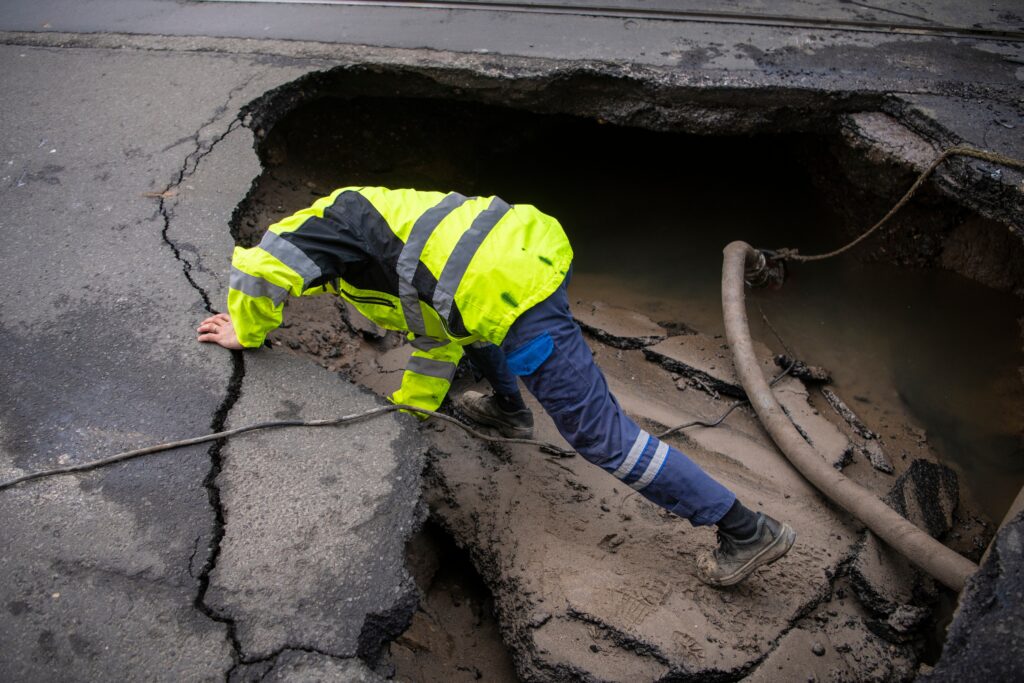Building science has come a long way, and homes today do a great job holding up against extreme elements like, blizzards, high-speed winds, sleet, rain, and punishing hail. Unfortunately, there are still times when modern designs often can’t hold up to mother nature: sinkholes.
Natural disasters cause over $64 billion dollars in damages every year in the US (see more from the National Centers for Environmental Information). Tornadoes, hurricanes, wildfires, and floods are well known for the damage they can leave in their wake. But there is another phenomenon that can also wreak havoc while being much tougher to see coming.
Our attention is often rightfully pointed towards the skies when we anticipate potential damage to our homes. However, sinkholes can open up beneath roads, local businesses, and even our own home foundations. Sinkholes can be major nuisances and serious hazards, so let’s discuss what you need to know to be prepared!
What Are Sinkholes?
Many have heard stories about massive holes that have appeared in the middle of city roads on the news. Sometimes, these openings have even caused entire sections of homes to collapse into the ground. The truth is, that sinkholes can appear over a short span of time, the bulk of their formation most likely occurred over hundreds to even thousands of years.
Natural sinkholes are most commonly created when acidic rain and groundwater finds its way into subsurface rock through small cracks and cavities. Over time, this leads to a process called internal erosion, which eats away at this underground rock layer. Materials that are especially susceptible to breaking down during internal erosion include carbonate rocks like limestone and dolomite, and evaporites like gypsum and salt. Areas with abundant carbonate rocks or evaporites are known as “karst terrain” regions.
Karst terrain regions are incredibly eroded, with caves and aquifers that are often compared to “swiss cheese” due to water continually expanding the openings in their rocky sub-layers. It’s in these regions where sinkholes are particularly known to form, as these naturally processes eventually will see the ground give way to internal erosion, taking roads, bridges, and even buildings along with it.
Periods of heavy rain can also exacerbate existing erosion, making sinkholes more likely to form quicker. Conversely, droughts can also influence the formation of sinkholes by lowering the water table within the earth and removing support from underground cavities. Whether it’s too much water or too little – both situations can lead to a sinkhole!
Sinkholes can happen nearly anywhere, but they are more common in karst terrain regions like Alabama, Missouri, Kentucky, Tennessee, Pennsylvania, Texas, and (maybe most famously) Florida. While the majority of sinkholes are small, many can grow to shocking sizes and cause serious structural damage to homes and public infrastructure.
How People (Might) Cause Sinkholes
While much sinkhole development occurs through these natural processes, sinkholes can also be caused by human activity or negligence, most obviously through water-pumping. Ground water is a major source of drinking water for homes, and is also crucial for things like irrigation and livestock. If communities tap into their ground water too much, this can certainly lead to permanent aquifer damage and – you guessed it – sinkholes!
Likewise, construction activity has also been known to affect sinkhole creation, first from destabilizing the area and disturbing soil layers through excavation and also simply through the presence of heavy machinery. Construction can also damage infrastructure, leading to leaks from sewer pipes or further redirecting water into already eroded areas.
From drilling and construction to buried materials (like discarded septic tanks and leftover construction debris), human activity can lead to hidden issues that are out of sight and just waiting to break through. Detecting a sinkhole before formation on the surface begins is extremely difficult, but that doesn’t mean that there aren’t any signs to watch out for.
Early Signs of Sinkholes
The main warning sign that homeowners need to be looking out for (particularly if they reside in a karst terrain region) is abnormal settlement. Windows and doors that are tough to open may indicate that a building’s foundation has shifted. However, jammed frames can also be due to damage or warping from temperature fluctuations.
Property owners should then also look to the structural integrity of their foundation for further indication, namely checking to see whether cracks have formed. Hairline foundation cracks shouldn’t cause alarm on their own, but thicker or non-vertically running cracks may signal serious issues that need to be addressed (whether that means sinkhole formation or something else). Learn more about different foundation cracks and what they might mean by visiting this resource page on Groundworks.
Often, all homeowners can do is react during the last stages of sinkhole formation by recognizing localized ground settlement in their yard, dead or dying sections of grass, tilting structures like fence posts, or cloudiness in their drinking water. If you suspect a sinkhole is forming near your home, evacuate the area and contact your local emergency services for assistance. Serious damage can occur quickly and personal safety should always be the top priority!
Best Defense Against Sinkholes
Unfortunately, due to the sudden nature of sinkhole formation, it is very tough to stop them from occurring altogether. The best thing that buyers can do is research the property that they’re interested in thoroughly as well as the surrounding region. If neighbors have had issues with sinkholes in the past, it’s safe to assume that the overall subsurface rock layer is prone to sinkhole formation.
Property owners in karst terrain regions or other areas prone to sinkhole dangers should confirm coverage with their insurance providers, and those that are concerned about imminent sinkhole formation should check with their state’s geological survey or a geotechnical engineer to discuss potential mitigation options. Tools like ground-penetrating radars can bring to light some level of subterranean activity, but fully addressing the issue will likely require specific excavation equipment.
Sinkholes are just one of many issues that regular home maintenance inspections from a trained professional can help homeowners stay ahead of. Find your local NPI inspector today for a quote



